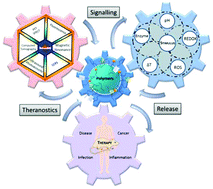Utilising polymers to understand diseases: advanced molecular imaging agents
Abstract
Polymers play an increasingly important role in the evolving field of nanomedicine. Their function might simply be to enhance the pharmacokinetics or pharmacodynamics of other nanomaterials or biologics, or to provide a scaffold for advanced molecular imaging probes that are activatable upon exposure to specific stimuli. In this review, we explore recent advances in the application of polymers in molecular imaging. Using selected examples that have demonstrated efficacious imaging in vivo, we describe the various aspects of polymeric systems that make them suitable for the most common imaging modalities. We then explore recent examples outlining the development of sophisticated nanomaterials that provide an insight into the function of biological systems through switchable probes. Finally, we describe new innovations in theranostics, where molecular imaging provides a means of monitoring therapeutic delivery. In all cases, we focus our discussion on examples where polymers have been used to enable molecular imaging to provide an insight on diseases in living animals.


 Please wait while we load your content...
Please wait while we load your content...